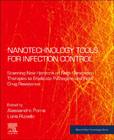
Nanotechnology Tools for Infections Control: Scanning New Horizons on Next-Generation Therapies to Eradicate Pathogens and Fight Drug Resistance
Poma, Alessandro
Rizzello, Loris
Nanotechnology Tools for Infections Control: Scanning New Horizons on Next-Generation Therapies to Eradicate Pathogens and Fight Drug Resistance provides an overview of recent strategies to build nanotechnology platforms, with a specific focus on biocompatible and biodegradable nanosystems. Particular attention is given to responsive nanoparticles, which are able to sense and respond to specific external stimuli (e.g., temperature, pH). The book includes details of the rationale behind the design of the raw materials, synthetic procedures and characterization techniques. It also introduces a new generation of nanomaterials, commonly named as 'nanobots', which are able to self-propel in response to external stimuli. Subsequent sections of the book focus on the applications of nanosystems as an alternative approach to standard antibiotics. The chapters describe their pharmokinetic and dynamics within the body, their ability to cross biological barriers and how they distribute within different body compartments. In this respect, a dedicated section highlights the crucial role of the immune system, as well as of protein corona, in changing the nanoparticles retention within the body. Coverage is also given to describe how nanosystems access different cells and their intracellular trafficking. Provides an overview of the current challenges in infection and immunity, showing how nanosystems can be used to meet them Focuses on the translational potential of nanotechnology for both clinical and commercial applications Assesses the major challenges of effectively using nanotechnology in immunology INDICE: Section 1. The Global Context1. Pandemic diseases: what are the current global health challenges?2. Antimicrobial drug resistance - a clinical perspective and current available solutions3. The significant drain in antimicrobial discovery by pharma companiesSection 2. Nanosystems - 'How To'4. Nanoparticles design for infection control5. Nanoparticles production for infection control6. Nanoparticles characterisation and standardisationSection 3. The Nano-Challenge7. Principle of body navigation of nanosystems8. The immune system and how to avoid body clearance9. The problem of protein corona10. Intracellular fate of nanosystems, their degradation and body accumulationSection 4. Antimicrobial Nanosystems11. State of the art and potential health and environmental risks12. Molecular targets and pharmacodynamics for bactericidal and bacteriostatic activity13. How to fight bacteria without inducing drug resistanceSection 5. The clinical drive14. Pre-clinical characterisation: which animal model is best for infection?15. Clinical translation of nanoparticles: why is it so difficult?16. Envisioned impact of nanotech for infection control: economy, government policy and public awareness17. Concluding remarks - What next?
- ISBN: 978-0-12-823994-0
- Editorial: Elsevier
- Encuadernacion: Rústica
- Páginas: 300
- Fecha Publicación: 01/02/2024
- Nº Volúmenes: 1
- Idioma: Inglés
